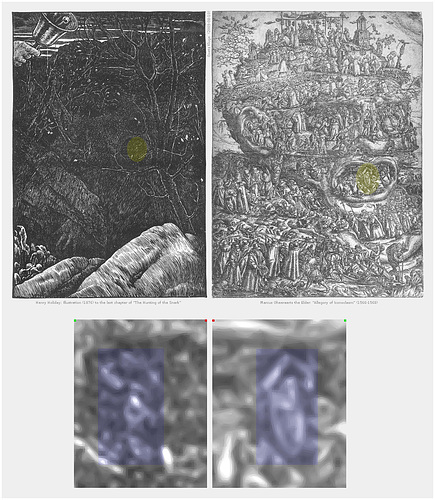Henry George Liddell in "The Hunting of the Snark"
La Cathédrale de Strasbourg
Southern Californian Factory
Detail from John Martin's "The Bard"
Bellman & Bard
Blakeekalb
Bellman & Bard after retinex filtering
Anne Hale Mrs. Hoskins
Happy Holidays!
The Monster in the Branches
No Mistake
John Martin's Bard and Henry Holiday's Snark Illus…
How to make The Omnipotent even more omnipotent
Dragon Attack - Where is St. George when you need…
Visage de l'apocalypse
The Swarm
Revenge on the Honey Thief
Creature
"But if ever I meet with a Boojum, that day, I sha…
電機!
IT WAS A BOOJUM
While he rattled a couple of bones
The Ancient of Bad Hair Days
The Bandersnatch fled as the others appeared
Me
See also...
See more...Keywords
Authorizations, license
-
Visible by: Everyone -
All rights reserved
-
2 764 visits
Hidden Carrol


Photographic self portrait by Lewis Carroll, and its inclusion into an illustration by Henry Holiday to Lewis Carroll's The Hunting of the Snark. In the drafts and in Holiday's drawing I didn't see that structure.
[top]: Henry Holiday: vectorized segment of an illustration (cut by Joseph Swain) to The Beaver's Lesson in Lewis Carroll's The Hunting of the Snark (1876)
[left]: Original detail
[center]: Low pass filtered detail
[right]: Photographic self portrait by Charles Lutwidge Dodgson (aka Lewis Carroll, May 1875) displayed in mirror view. (Credits for the photo: Watts Gallery, Compton, Guildford)
Perhaps Joseph Swain (the cutter) played a bigger role in this allusion&citation game. I think that C. L. Dodgson (Lewis Carroll) knew about Henry Holiday's allusions. There even may have been a cooperation in combining pictorial and textual allusions. But how can we be sure that Carroll/Dodgson knew about the "hidden Carroll" and the provoking simulacrum (based on a fold in the suit) in that picture?
This comparison also shows, how low pass filtering (blurring) can help. It removes unimportant details in a similar way as our eye/brain "removes" the single dots in a dithered image. In 2009 I initially used the illustrations in the Snark version of Ebooks Adelaide. Due to their low resolution they were blurred renderings of Holiday's illustrations already. Without the blurring I perhaps would not have noticed the first allusion which I found in December 2008.

[top]: Henry Holiday: vectorized segment of an illustration (cut by Joseph Swain) to The Beaver's Lesson in Lewis Carroll's The Hunting of the Snark (1876)
[left]: Original detail
[center]: Low pass filtered detail
[right]: Photographic self portrait by Charles Lutwidge Dodgson (aka Lewis Carroll, May 1875) displayed in mirror view. (Credits for the photo: Watts Gallery, Compton, Guildford)
Perhaps Joseph Swain (the cutter) played a bigger role in this allusion&citation game. I think that C. L. Dodgson (Lewis Carroll) knew about Henry Holiday's allusions. There even may have been a cooperation in combining pictorial and textual allusions. But how can we be sure that Carroll/Dodgson knew about the "hidden Carroll" and the provoking simulacrum (based on a fold in the suit) in that picture?
This comparison also shows, how low pass filtering (blurring) can help. It removes unimportant details in a similar way as our eye/brain "removes" the single dots in a dithered image. In 2009 I initially used the illustrations in the Snark version of Ebooks Adelaide. Due to their low resolution they were blurred renderings of Holiday's illustrations already. Without the blurring I perhaps would not have noticed the first allusion which I found in December 2008.

(deleted account) has particularly liked this photo
- Keyboard shortcuts:
Jump to top
RSS feed- Latest comments - Subscribe to the comment feeds of this photo
- ipernity © 2007-2024
- Help & Contact
|
Club news
|
About ipernity
|
History |
ipernity Club & Prices |
Guide of good conduct
Donate | Group guidelines | Privacy policy | Terms of use | Statutes | In memoria -
Facebook
Twitter

- Charles Darwin
- Charles Lutwidge Dodgson (Lewis Carroll)
- Henry Holiday
- Benjamin Jowett
- Henry George Liddell
Sign-in to write a comment.